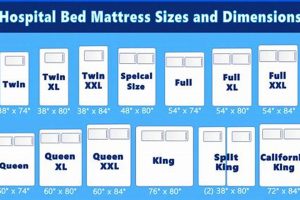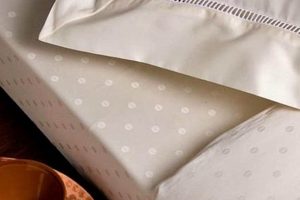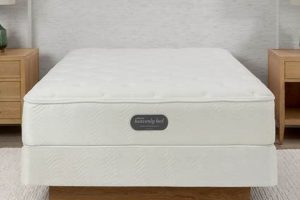The underlying structure upon which a sleeping surface rests is crucial for both comfort and the longevity of the mattress itself. This foundation, often composed of materials like wood, metal, or composite structures, provides a stable and even plane. For instance, a platform bed with closely spaced slats represents one type, while a traditional box spring offers another approach to bolstering the mattress above it.
Appropriate undergirding promotes spinal alignment and reduces pressure points, contributing to improved sleep quality. A suitable base distributes weight evenly, preventing premature sagging and degradation of the mattress material. Historically, rudimentary structures like straw-filled pallets evolved into more sophisticated designs, reflecting advancements in material science and understanding of ergonomic principles. This component is important for ensuring a restful sleep and protecting your investment.
Therefore, an investigation into various types of platforms, the impact of slat spacing, and the merits of different construction materials is warranted. Analyzing these elements will provide a clearer understanding of how to select the optimal base to maximize mattress performance and sleep well-being.
Optimizing the Sleep Experience
Selecting the correct structural foundation is vital for ensuring mattress longevity and promoting optimal sleep posture. Adhering to the following guidelines can aid in making an informed decision.
Tip 1: Assess Mattress Type Compatibility: Different mattress types require specific foundations. Memory foam mattresses generally benefit from solid or closely spaced slat platforms, while innerspring mattresses may function effectively with traditional box springs. Consult the mattress manufacturer’s recommendations.
Tip 2: Evaluate Slat Spacing: For slatted platforms, ensure that the spacing between slats is no greater than two to three inches. Excessive spacing can lead to sagging and uneven wear, particularly for thicker mattresses.
Tip 3: Consider Weight Distribution: Individuals with higher body weights should prioritize robust platforms constructed from durable materials such as hardwood or reinforced steel. Confirm that the platform’s weight capacity meets or exceeds the combined weight of the mattress and sleepers.
Tip 4: Inspect for Center Support: King and Queen-size mattresses, due to their larger surface area, necessitate center support beams. Verify the presence of a center support system to prevent sagging in the middle.
Tip 5: Account for Bed Frame Compatibility: If utilizing an existing bed frame, confirm that the platform or foundation fits securely within the frame. Ill-fitting supports can compromise stability and create undesirable noise.
Tip 6: Investigate Material Quality: Prioritize platforms constructed from high-quality materials. Solid wood or steel frameworks offer superior durability compared to cheaper alternatives like particleboard.
Tip 7: Regular inspection for Damages: Check your foundation every month or so for any signs of damage. This will extend the lifespan of your mattress support system and maintain its performance.
Implementing these strategies will contribute to a more comfortable and supportive sleep environment, while also protecting the integrity of the mattress itself.
By applying these guidelines, readers can make more informed decisions regarding their foundation, thereby maximizing the benefit of their sleeping arrangements.
1. Firmness
Firmness, as it pertains to structural reinforcement, directly influences the degree to which a mattress conforms to the sleeper’s body. Insufficient firmness can lead to excessive sinkage, disrupting spinal alignment and potentially causing discomfort or pain. Conversely, excessive firmness may create pressure points, hindering restful sleep. The ideal level represents a balance between these extremes, promoting proper skeletal support while accommodating individual body contours. For instance, a foundation with inadequate firmness may cause a memory foam mattress to sag prematurely, negating its intended pressure-relieving properties. Therefore, a precise firmness rating is necessary.
The selection of an appropriate firmness level should align with the specific characteristics of the mattress. Softer mattresses often require a firmer foundation to prevent excessive compression and maintain structural integrity. Firmer mattresses, on the other hand, may pair well with a slightly more yielding base to enhance comfort. A practical example lies in the use of adjustable beds, where the firmness of the integrated foundation can be adjusted to accommodate varying sleep positions and preferences, providing tailored support.
The correct level is not merely a matter of comfort but also plays a critical role in the longevity of the mattress and the long-term health of the sleeper. Selecting a foundation with mismatched firmness could accelerate mattress wear, reduce sleep quality, and potentially exacerbate existing musculoskeletal issues. Understanding the relationship between firmness and undergirding is, therefore, essential for maximizing the benefits of a quality mattress and achieving optimal sleep health.
2. Durability
Durability constitutes a critical attribute of the structural foundation, directly affecting its capacity to provide consistent and reliable performance over extended periods. The longevity of this foundation impacts both the lifespan of the mattress it supports and the ongoing quality of sleep experienced by the user.
- Material Composition and Longevity
The selection of materials significantly influences the long-term resilience. Solid wood, steel, and high-density composites offer superior resistance to wear and tear compared to less robust alternatives like particleboard. For instance, a steel frame is less prone to bending or warping under continuous weight than a wooden frame, providing more consistent support over time.
- Joint Strength and Structural Integrity
The method of joining components plays a pivotal role in maintaining structural integrity. Reinforced joints, such as those employing bolts and screws rather than simple adhesives, enhance the foundation’s ability to withstand stress and movement. Weak joints can lead to instability and premature failure, diminishing the level of assistance provided to the mattress.
- Resistance to Environmental Factors
Exposure to humidity, temperature fluctuations, and potential pest infestations can compromise the integrity. Materials treated to resist moisture and pests exhibit enhanced durability. For example, platforms constructed with kiln-dried wood are less susceptible to warping or cracking due to changes in humidity levels.
- Impact of Weight Load and Distribution
The foundation’s
ability to uniformly distribute weight directly affects its durability. Uneven weight distribution can concentrate stress on specific points, accelerating wear and potentially leading to structural failure. Foundations designed with ample support beams and evenly spaced slats are better equipped to manage weight and maintain their structural integrity.
In essence, the selection of a durable foundation represents a long-term investment in both mattress preservation and sustained sleep quality. Careful consideration of material composition, joint strength, environmental resistance, and weight load capacity is essential for ensuring that the base continues to provide reliable support throughout its lifespan.
3. Compatibility
The notion of compatibility, in the context of structural reinforcement, transcends simple fit, encompassing the harmonious interaction between the mattress and its underlying foundation. This interconnectedness is paramount for optimizing both the performance and longevity of the sleep system.
- Mattress Type Specificity
Distinct mattress types, such as innerspring, memory foam, latex, or hybrid models, possess unique structural characteristics and support requirements. A foundation designed for one type may prove unsuitable for another. For example, a traditional box spring, optimized for innerspring mattresses, may not provide adequate support for a memory foam mattress, potentially leading to premature sagging and diminished comfort.
- Slat Design and Spacing Considerations
The design and spacing of slats on a platform base exert a significant influence on weight distribution and ventilation. Insufficient slat density or excessive spacing can create uneven support, resulting in pressure points and compromising the integrity of the mattress. Conversely, closely spaced slats promote even weight distribution and enhance airflow, contributing to a more comfortable and durable sleep surface.
- Foundation Height and Bed Frame Integration
The height of the foundation must align with the dimensions of the existing bed frame to ensure a proper fit and aesthetic consistency. An incompatible height can result in an unstable sleep surface or an aesthetically unappealing appearance. Furthermore, the method of attachment between the foundation and bed frame must be secure to prevent shifting or movement during use.
- Weight Capacity Synchronization
The weight capacity of the foundation must meet or exceed the combined weight of the mattress and sleepers to avoid structural failure. Overloading a foundation can lead to premature wear, sagging, or even collapse, compromising the support provided to the mattress and potentially posing a safety hazard. A robust foundation, rated to accommodate the intended weight load, ensures both long-term stability and safety.
In summary, achieving optimal compatibility requires a comprehensive understanding of mattress characteristics, foundation design, and the interplay between the two. Selecting a foundation that is specifically designed to complement the mattress type, bed frame, and weight requirements ensures both maximum comfort and the extended lifespan of the entire sleep system.
4. Slat Spacing
Slat spacing, a crucial design element in platform foundations, directly impacts the level of assistance provided to a mattress. The distance between slats affects weight distribution, ventilation, and overall structural integrity, all of which are critical to the performance and longevity of the mattress.
- Impact on Weight Distribution
Closely spaced slats promote more even distribution of weight across the mattress surface, reducing pressure points and preventing premature sagging. Conversely, wider spacing can concentrate weight on fewer points, leading to uneven wear and potential damage. For instance, a memory foam mattress placed on a platform with widely spaced slats may develop indentations over time, compromising its comfort and support.
- Influence on Mattress Ventilation
Adequate spacing facilitates airflow around the mattress, reducing moisture buildup and minimizing the risk of mold or mildew growth. Conversely, tightly packed slats can restrict ventilation, creating a damp environment that is conducive to microbial growth. Proper ventilation is particularly important for mattresses made from materials that are prone to trapping moisture, such as memory foam or latex.
- Relationship to Mattress Warranty Requirements
Many mattress manufacturers specify minimum slat spacing requirements in their warranty terms. Using a foundation with wider spacing than recommended can void the warranty, leaving the owner liable for any damage that occurs due to inadequate support. Adhering to the manufacturer’s guidelines is essential for maintaining warranty coverage and ensuring the longevity of the mattress.
- Contribution to Structural Stability
Proper spacing ensures the structural stability of the entire support system. If the spacing is too wide, the slats themselves may be prone to bending or breaking under load, compromising the stability of the platform. Closely spaced slats, constructed from durable materials, provide a more robust and reliable foundation for the mattress.
In essence, selecting a platform with appropriate slat spacing is a critical factor in optimizing mattress performance and maximizing its lifespan. Consideration of weight distribution, ventilation, warranty requirements, and structural stability is essential for ensuring that the slats provide adequate and consistent assistance to the mattress.
5. Weight Capacity
Weight capacity, in the realm of bed foundation, represents a fundamental parameter directly influencing the structural integrity and long-term performance of the support system. It quantifies the maximum load that the frame can withstand without compromising its intended function or risking failure.
- Structural Load Limits
The inherent strength of the materials used in construction dictates the structural load limits. Frames constructed from reinforced steel, for example, exhibit higher weight capacities compared to those fabricated from lower-density wood composites. Exceeding these limits can result in bending, cracking, or complete collapse, compromising the stability and safety of the sleep system. An instance involves a king-size memory foam mattress and two adults surpassing the wooden frame’s intended capacity, resulting in noticeable sagging and eventual structural failure.
- Distribution of Mass
Even distribution of mass across the base is essential for maximizing weight capacity. Uneven distribution concentrates stress on specific areas, potentially leading to localized weakening and premature failure. For instance, consistently sitting on one side of the bed places undue stress on that area, accelerating wear and tear on the frame’s support structure. Proper design incorporates evenly spaced slats or a continuous surface to mitigate stress concentration.
Impact on Mattress Longevity Insufficient weight capacity directly impacts mattress longevity. A foundation unable to adequately support the mattress leads to uneven wear, sagging, and ultimately, a reduction in its lifespan. A memory foam mattress, unsupported by an appropriate platform, will exhibit premature compression and loss of its conforming properties. A properly rated foundation preserves the mattress’s integrity and extends its useful life.
- Safety Considerations
Exceeding the specified capacity poses a safety risk to occupants. Structural failure can result in injury due to sudden collapse or instability. Children jumping on a bed exceeding its weight limits create a high-impact scenario that could lead to the supports breaking. Therefore, adhering to the manufacturer’s recommendations regarding weight capacity is crucial for ensuring the safety and well-being of users.
In essence, weight capacity functions as a critical design parameter that dictates the performance and reliability of bed reinforcement. Selecting a foundation that appropriately accommodates the combined weight of the mattress and occupants is essential for ensuring structural integrity, maximizing mattress lifespan, and ensuring user safety.
6. Center Support
Center support represents a critical component of effective reinforcement, particularly in larger-sized mattresses. Its primary function is to mitigate sagging in the middle, a common issue arising from prolonged use and weight distribution. Without adequate center reinforcement, the mattress loses its uniform plane, resulting in compromised sleep posture and accelerated wear. For example, a king-size bed lacking center support may exhibit a noticeable dip over time, impacting spinal alignment and potentially causing discomfort.
The implementation of center support typically involves a rigid beam or a series of legs positioned beneath the center of the mattress. This structural element counteracts the downward force exerted by the mattress and occupants, maintaining a level surface across the entire sleeping area. Steel support beams are common on metal frames. A well-designed center support system distributes weight evenly, preventing localized compression and promoting mattress longevity. The absence of such support often voids mattress warranties, highlighting its significance in maintaining structural integrity.
Ultimately, center support is not merely an optional feature but an essential element for enhancing and preserving the functionality of the overall sleeping surface. Proper incorporation of this support mechanism contributes to improved sleep quality, extended mattress lifespan, and the avoidance of potential musculoskeletal issues. Ignoring this aspect can lead to premature replacement costs and compromised sleep health, underscoring the practical significance of understanding and implementing effective center reinforcement.
Frequently Asked Questions
The following addresses common inquiries regarding reinforcement structures for mattresses, offering objective and factual information to aid in informed decision-making.
Question 1: What constitutes appropriate reinforcement for a memory foam mattress?
Memory foam mattresses generally require a solid or closely spaced slatted platform to prevent sagging. Traditional box springs may not provide adequate assistance for this type of mattress.
Question 2: How does slat spacing affect mattress performance?
Excessive space between slats concentrates weight on smaller areas of the mattress, potentially leading to uneven wear and premature sagging. The space should ideally be no more than a few inches.
Question 3: Is center reinforcement necessary for larger mattresses?
King and queen-size mattresses typically require center reinforcement to prevent sagging in the middle. The absence of center support can compromise spinal alignment and reduce mattress lifespan.
Question 4: Can an unsuitable reinforcement structure void a mattress warranty?
Yes, using a base that does not meet the manufacturer’s specifications can void the mattress warranty. Consult the warranty documentation for specific requirements.
Question 5: What materials are considered durable for platform bed construction?
Solid wood, steel, and high-density composites generally offer superior durability compared to particleboard or other less robust materials.
Question 6: How does weight capacity impact the selection of a bed frame?
The combined weight of the mattress and sleepers should not exceed the weight capacity of the frame. Exceeding the weight limit can lead to structural damage and compromise safety.
Selecting the correct assistance system is essential for optimizing mattress performance, prolonging its lifespan, and ensuring a comfortable and supportive sleep environment.
The subsequent material will delve into the various types of bed frames and their suitability for different mattress types.
Bed Mattress Support
Throughout this exploration, the essential role of “bed mattress support” has been underscored. From understanding the nuances of slat spacing and material durability to acknowledging the importance of weight capacity and center reinforcement, each element contributes significantly to the overall effectiveness of a sleep system. Inadequate structures can compromise spinal alignment, accelerate mattress degradation, and ultimately detract from sleep quality. Therefore, diligent consideration of these factors represents a crucial step toward a more restful and restorative sleep experience.
The selection of an appropriate base is not merely an aesthetic choice but a long-term investment in both physical well-being and mattress longevity. Continued research and innovation in structural design will undoubtedly lead to further advancements in sleep technology. Prioritizing informed decision-making ensures that individuals can harness these advancements to optimize their sleep health for years to come.


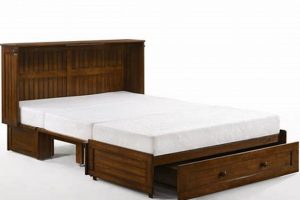
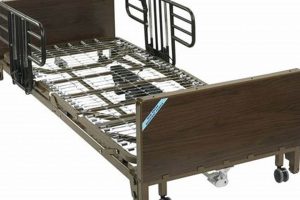
![Best Air Bed Double Mattress [Deals] For Comfy Nights! Organic & Natural Mattress Buyer’s Guide: Non-Toxic Sleep Solutions Best Air Bed Double Mattress [Deals] For Comfy Nights! | Organic & Natural Mattress Buyer’s Guide: Non-Toxic Sleep Solutions](https://mattressworldpa.com/wp-content/uploads/2025/07/th-7086-300x200.jpg)
